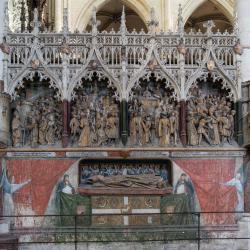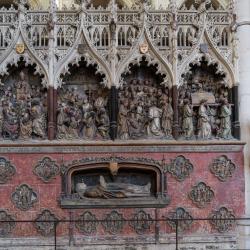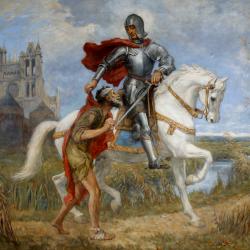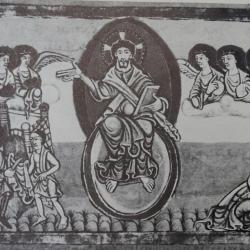The search for Christian roots
West façade, north portal of Saint Firmin (c.1230)
The arrival of Christianity in Amiens is not documented. It is celebrated in the cathedral with the story of the legendary 2nd-century Spanish missionary Firmin who was said to have been the first bishop of Amiens. His story is told in the sculpture of the north portal and the lateral screen (clôture) of the choir.
Saint Martin was probably baptized in Amiens and the famous miracle of Saint Martin and the beggar took place outside the city gate.
The Miracle of St. Firmin (north portal and clôture)
In the lower lintel six bishops sit on either side of an architectural canopy: these are the early bishops of Amiens with the box (châsse) containing the relics of Saint Firmin at the center.
At the center of the upper lintel Bishop Sauve is guided by a ray of light from heaven (it looks like a rope coming down) to the tomb: Saint Firmin's body, emanating a sweet odor) is found intact. Men and women and children from the neighboring cities of Beauvais, Cambrai, Arras and Thérouanne are drawn by the sweet odor to participate in the miracle.
The box (châsse) containing the relics is carried in procession back to Amiens. As it approaches the city boys climb trees and strew fronds on the road (echoing the Triumphal Entry of Christ to Jerusalem). On the left a young man follows: the heat has caused him to remove his overcoat. On his head is a foliate crown: this is the Green Man (l'homme vert) who features in the liturgy of celebration of the Feast of the Invention of the saint.
Text from the Acta Sanctorum
Since people did not know where the body of Christ's holy martyr lay, thanks to the instructions of the Holy Spirit [Bishop Sauve] came to the place where Christ's martyr lay and, raising his eyes to heaven, with indescribable terror he saw as if a ray of light coming from a lofty throne lighting the place where Saint Firmin Lay. Grateful for this sign of divine mercy he began quickly and very reverently to dig and to open to tomb of the holy martyr. The odor that emanated was so sweet and alluring it was as if all kinds of colors and scents were crusted together and the countryside was alive with the beauty of various flowers. He [Sauve] raised him up from the tomb and set out for the city [of Amiens], the people bearing the holy martyr. Crowds of people rushed up on the way, throwing their clothes on the road and crying in a loud voice: "Hosanna in the highest; blessed is he who omes in the name of the Lord." The most blessed bishop Sauve placed [the body] in the eastern crypt of the splendid church he had constructed in honor of the said martyrs and buried him with dignity and honor, embellishing the tomb with gold and gems.
Everyone there thought that white lilies and live roses and other green plants and flowers were beautifully sprouting from inside the tomb, and the more people that came to the holy miracle the greater became the odor and it flowed over the entire diocese of Amiens widely spreading its pleasant stream to the other cities of the diocese. And the entire populations of the cities of Thérouanne, Cambrai, Noyon and Beauvais, satiated at that time by the sweetness and delicacy of that wonderful odor thought that they had come to the delights of paradise.
And then, as the venerable Bishop Sauve ... raised Firmin from his tomb, the substance of all the elements was changed, and such a boiling heat came into the world that all the people present, stupified and in a state of ecstacy, where amazed.
Saint Martin
Life of Saint Martin of Tours by Sulpicius Severus (363-c420)
Martin was born c 336 in Roman Pannonia (Hungary) became bishop of Tours c 372, died 397
So it came about that one day when he had nothing on him but his weapons and his uniform, in the middle of a winter that had been fearfully hard beyond the ordinary, so that many were dying from the intense cold, he met at the city gate of Amiens a coatless beggar. This beggar had been asking the passers-by to take pity on him but all had gone past the unfortunate creature. Then the God-filled man understood ... that this beggar had been reserved for him. But what was he to do? He had nothing with him but the cape he had on, for he had already used up what else he had in similar good works. So he took the sword he was wearing and cut the cape in two and gave one half to the beggar, putting on the rest himself again.
This raised a laugh from some of the bystanders for he looked grotesque in the mutilated garment; but many had more sense, and sighed to think that they had not done something of the kind, indeed, having more to give they could have clothed the beggar without stripping themselves. And that night, in his sleep, Martin saw Christ wearing the half of his cape with which he had clothed the beggar. .... Then he heard Jesus say aloud to the throng of angels that surrounded him, "Martin is still only a catechumen [ie. not yet baptised] but he has clothed Me with this garment.
St. Martin and the Beggar (334/54) story told by Sulpicius Severus



